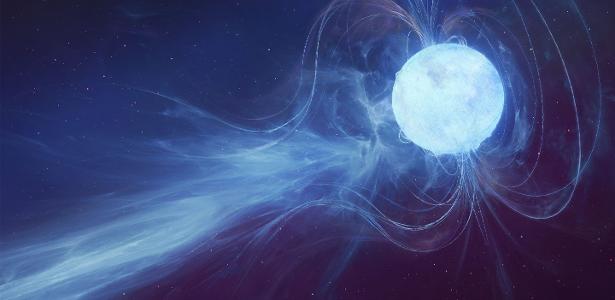Astronomers have discovered a persistent radio signal from a galaxy far from Earth, about a billion light-years away. Dubbed FRB 20191221A, the repeating pattern of this signal resembles the beating of a heart, scientists say.
The phenomenon is of the FRB type (fast radio bursts): brief and very intense flashes of radio waves, which propagate throughout the Universe. Just one of these explosions can release more energy than our Sun emits in 80 years. The exact astrophysical origins of the phenomenon are still a mystery.
Unexpected, these bursts usually last a few milliseconds and then disappear. The newly detected signal, however, lasts about three seconds – about a thousand times longer and a million times brighter than usual. It is the largest FRB ever discovered, and the first with such a periodic signal.
“Not only was it long lasting, at about three seconds, but it had oddly precise periodic spikes emitted every fraction of a second, like heartbeats,” said MIT researcher Daniele Michilli (Massachusetts Institute of Technology, USA). States) and co-author of a study on the subject, published this week in Nature magazine.
The exact location of the galaxy from which the signal originated and the object in question are unknown. Studying it can provide clues to its origins and a fuller view of the outer reaches of the cosmos.
how was the study
On December 21, 2019, astronomers monitoring data from the Canadian radio telescope Chime (Canadian Hydrogen Intensity Mapping Experiment) detected a particular signal, which caught our attention. “I inspected the signal myself and noticed that it was made up of multiple pulses. It looked a bit like an electrocardiogram,” Michilli said.
Upon further analysis, the team found a clear periodic pattern in the pulses, similar to a heartbeat, which repeated every 0.2 seconds. “That surprised us, because there aren’t many sources in the Universe that can produce that kind of signal.”
According to the researcher, FRB 20191221A could be related to two different types of neutron stars (remains of the death of a huge Sun) in our galaxy: a magnetar or a radio pulsar.
A magnetar is dense and has an incredibly strong magnetic field; a pulsar releases narrow beams of waves as it rotates. They send out predictable and reliable signals, like the flashing light of a coastal lighthouse, passing Earth from time to time.
Because it matters?
Most fast radio bursts occur only once; only 10% of them show a repetition or a pattern. Therefore, astronomers use these consistent and repetitive signals to study theories.
For example, the frequency and change of the emission, depending on the movement of the object emitting it, can serve as a kind of clock to measure the rate of expansion of the Universe.
The repeating signals allow scientists to point telescopes at that particular part of the sky and study the explosion in more detail, to find out exactly where it came from and what caused it.
While the new signal appears to come from a single event, with multiple spikes (like a beating heart), the team has yet to see the explosion repeat itself. “We hope to continue monitoring to see additional bursts from this FRB and discover similar ones in the future,” Michilli said.
To that end, Chime is being expanded, in collaboration with other telescopes across North America. Together they will observe the same piece of sky, to triangulate the locations of the bursts and link them to specific galaxies.
“We want to know exactly where they come from and study their local environment,” explained the astronomer. “And in the future, we hope to examine some of them with the new James Webb Space Telescope, to see exactly what they are and what’s around them.”
*With information from Insider sites and MIT

“Pop culture fan. Coffee expert. Bacon nerd. Infuriatingly humble communicator. Friendly gamer.”





:strip_icc()/s01.video.glbimg.com/x720/7214172.jpg)
